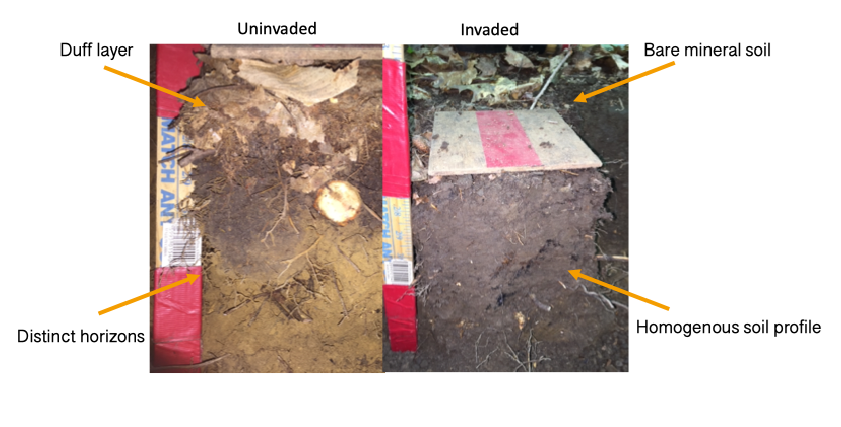|
Getting your Trinity Audio player ready...
|
Annise Dobson discusses her article: ‘Individual and combined effects of invasive earthworms and native white-tailed deer on understory plant survival, growth, and reproduction.’

Background
In northeastern U.S. forests, understorey plant communities are undergoing sweeping transformations. Knowing what to do to achieve our conservation goals is complicated by the fact that many of these stressors co-occur in the same forests, over the same timeframe, and often at the same scales. At local scales, the introduction of non-native earthworms and high browsing pressure from white-tailed deer have emerged as critical factors impacting ecosystem dynamics. Earthworms, spreading mainly due to human activities, are altering soil properties, leading to the disappearance of the leaf litter layer and re-engineering the forest floor. Concurrently, deer populations have rebounded due to conservation efforts, land-use changes, and lack of natural predators, and are reshaping plant communities through selective browsing. This not only affects plant survival and reproduction but also facilitates spread of invasive species and disrupts nutrient cycling.
The Study

Our study assessed the capacity of secondary forests to support native understory plants. We chose five different hardwood forests in central New York State for our field experiment. We transplanted native plants into both fenced (to exclude deer) and unfenced plots, in areas with and without existing earthworm invasions. We transplanted 20 individuals of 20 native species into each of 20 plots. We then measured survival, growth, and reproduction of the transplants over four to six years.
Key Findings
- Earthworm Influence: Earthworms limited early survival of many native plant species. Over time, earthworm impacts on survival shift from universally negative to species-specific. If a plant became established despite early rooting stress in earthworm-invaded soils, they can benefit from earthworm-enhanced growth, but will also be a more vulnerable to insect attack.
- Deer Exclusion Benefits: Excluding deer generally resulted in better survival and growth for most species once they reached the ‘molar zone’ of around 10-20cm. Interestingly, this included species typically considered unpalatable to deer.
- Traits and Taxonomy: Our study revealed that neither the taxonomic class nor specific plant traits like Specific Leaf Area (SLA) or foliar nitrogen significantly influenced species sensitivity to deer or earthworms.
Synthesis and Implications for Conservation

Our research demonstrates that secondary forests in the region continue to offer suitable habitats for native species, despite the challenges they face. The specific impacts of earthworms and deer evolve over time, underlining the need for species-specific management strategies. Further refining management strategies with demographic tools (e.g. predicting outcomes by mathematically modeling life stage transitions of plants) could optimize conservation efforts within safety and budget constraints. Importantly, our findings indicate that transplanting native species into these forests could be a viable strategy for understory restoration, provided there are measures to limit deer browse pressure.
